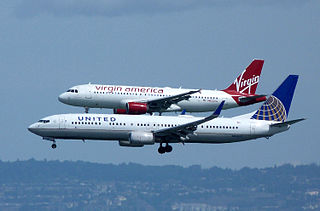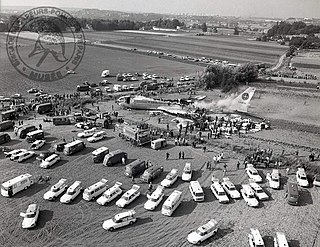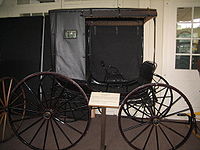
The Boeing 767 is an American wide-body aircraft developed and manufactured by Boeing Commercial Airplanes. The aircraft was launched as the 7X7 program on July 14, 1978, the prototype first flew on September 26, 1981, and it was certified on July 30, 1982. The initial 767-200 variant entered service on September 8, 1982, with United Airlines, and the extended-range 767-200ER in 1984. It was stretched into the 767-300 in October 1986, followed by the extended-range 767-300ER in 1988, the most popular variant. The 767-300F, a production freighter version, debuted in October 1995. It was stretched again into the 767-400ER from September 2000.

An airliner is a type of aircraft for transporting passengers and air cargo. Such aircraft are most often operated by airlines. The modern and most common variant of the airliner is a long, tube shaped, and jet powered aircraft. The largest of them are wide-body jets which are also called twin-aisle because they generally have two separate aisles running from the front to the back of the passenger cabin. These are usually used for long-haul flights between airline hubs and major cities. A smaller, more common class of airliners is the narrow-body or single-aisle. These are generally used for short to medium-distance flights with fewer passengers than their wide-body counterparts.

The Boeing 757 is an American narrow-body airliner designed and built by Boeing Commercial Airplanes. The then-named 7N7, a twinjet successor for the trijet 727, received its first orders in August 1978. The prototype completed its maiden flight on February 19, 1982, and it was FAA certified on December 21, 1982. Eastern Air Lines placed the initial 757-200 variant in commercial service on January 1, 1983. A package freighter (PF) variant entered service in September 1987 and a combi model in September 1988. The stretched 757-300 was launched in September 1996 and began service in March 1999. After 1,050 had been built for 54 customers, production ended in October 2004, while Boeing offered the largest 737 NG variants as a successor.

A flight attendant, traditionally known as a steward or stewardess ; or air host or hostess, is a member of the aircrew aboard commercial flights, many business jets and some government aircraft. Collectively called cabin crew, flight attendants are primarily responsible for passenger safety and comfort.

Philippine Airlines Flight 434, sometimes referred to as PAL434 or PR434, was a flight on December 11, 1994, from Cebu to Tokyo on a Boeing 747-283B that was seriously damaged by a bomb, killing one passenger and damaging vital control systems, although the plane was in a repairable state. The bombing was a test run of the unsuccessful Bojinka terrorist attacks. The Boeing 747 was flying the second leg of a route from Ninoy Aquino International Airport, Pasay in the Philippines, to Narita International Airport, in Tokyo, Japan, with a stop at Mactan–Cebu International Airport, Cebu, in the Philippines. After the bomb detonated, 58-year-old veteran pilot Captain Eduardo "Ed" Reyes was able to land the aircraft, saving it and the remaining passengers and crew.

A low-cost carrier or low-cost airline (LCC), also called no-frills, budget or discount carrier or airline, is an airline that is operated with an emphasis on minimizing operating costs. It sacrifices certain traditional airline luxuries, for cheaper fares. To make up for revenue lost in decreased ticket prices, the airline may charge extra fees such as for carry-on baggage. As of April 2020, the world's largest low-cost carrier is Southwest Airlines, which operates primarily in the United States, as well as in some surrounding areas.

Pan Am Flight 73 was a Pan American World Airways flight from Bombay, India, to New York, United States, with scheduled stops in Karachi, Pakistan, and Frankfurt, West Germany.

The 1985 Manchester Airport disaster occurred when British Airtours Flight 28M, an international passenger flight, was en-route from Manchester Airport to Corfu International Airport and caught fire on takeoff on 22 August, 1985. The accident resulted in 55 fatalities.
To assume a brace position or crash position is an instruction that can be given to prepare for a crash, such as on an aircraft; the instruction to "Brace for impact!" or "Brace! Brace!" is often given if the aircraft must make an emergency landing on land or water. There are many different ways to adopt the brace position, with many countries adopting their own version based on research performed by their own aviation authority or that of other countries. The most common in passenger airliners being the forward-facing seat version, in which the person bracing places their head against or as close as possible to the surface it is likely to strike, placing their feet firmly on the floor, and their hands either on their head or the seat in front.

Aircrew, also called flight crew, are personnel who operate an aircraft while in flight. The composition of a flight's crew depends on the type of aircraft, plus the flight's duration and purpose.
Economy class, also called third class, coach class, steerage, or to distinguish it from the slightly more expensive premium economy class, standard economy class or budget economy class, is the lowest travel class of seating in air travel, rail travel, and sometimes ferry or maritime travel. Historically, this travel class has been called tourist class or third class on ocean liners.

Singapore Airlines Flight 006 was a scheduled Singapore Airlines passenger flight from Singapore Changi Airport to Los Angeles International Airport via Chiang Kai-shek International Airport near Taipei, Taiwan. On 31 October 2000, at 23:18 Taipei local time, the Boeing 747-412 operating the flight attempted to take off from the wrong runway at Chiang Kai-shek International Airport during a typhoon. The aircraft crashed into construction equipment on the runway, killing 83 of the 179 people aboard. Ninety-eight occupants initially survived the accident, but two passengers died later from injuries in hospital. It was the first fatal accident involving a Boeing 747-400; it is also the first Singapore Airlines accident to result in fatalities.

Miracle Landing is a 1990 American made-for-television drama film based on an in-flight accident aboard Aloha Airlines Flight 243 that occurred in April 1988. The Boeing 737-200 was flying from Hilo, Hawaii to Honolulu, Hawaii, when it experienced rapid decompression when a section of the fuselage was torn away. With one flight attendant blown from the cabin to her death and 65 others injured, the aircraft was able to make a successful emergency landing at Kahului Airport, on Maui.

A pre-flight safety briefing is a detailed explanation given before take-off to airline passengers about the safety features of the aircraft they are aboard.

Varig Flight 820 was a flight of the Brazilian airline Varig that departed from Galeão International Airport in Rio de Janeiro, Brazil, on 11 July 1973, for Orly Airport, in Paris, France. The plane, a Boeing 707, registration PP-VJZ, made an emergency landing in onion fields about five kilometres from Orly Airport, due to smoke in the cabin from a fire in a lavatory. The fire caused 123 deaths; there were only 11 survivors . Relief Captain Antonio Fuzimoto was the pilot who handled the controls and landed the plane in the field.

An airline seat is a seat on an airliner in which passengers are accommodated for the duration of the journey. Such seats are usually arranged in rows running across the airplane's fuselage. A diagram of such seats in an aircraft is called an aircraft seat map.

An aircraft cabin is the section of an aircraft in which passengers travel. Most modern commercial aircraft are pressurized, as cruising altitudes are high enough such that the surrounding atmosphere is too thin for passengers and crew to breathe.

The Japanese Air Force One and Japanese Air Force Two are the radio callsigns of the two Boeing 777-300ER aircraft used by the government of Japan for overseas travel by the Emperor, Prime Minister and other high-ranking officials. Each aircraft has a capacity of 140 passengers and can be used for emergency evacuations of Japanese citizens and overseas deployment of Japan Self-Defense Forces personnel. The aircraft are operated by the Japan Air Self-Defense Force.
An exit row is a row of seats on board a commercial airliner that is next to an emergency exit. Exit rows may be next to overwing exits or full-sized exit doors.

Delta Air Lines Flight 1288 was a regularly scheduled flight from Pensacola, Florida to Atlanta, Georgia. On July 6, 1996, the aircraft serving the flight, a McDonnell Douglas MD-88, was on takeoff roll from Runway 17 at Pensacola when it experienced an uncontained, catastrophic turbine engine failure that caused debris from the front compressor hub of the left engine to penetrate the left aft fuselage. The cause of the engine failure was found to have been a fault in the manufacture of the fan. The failure of the airline to spot the resulting crack in the blade was a contributing factor.




















